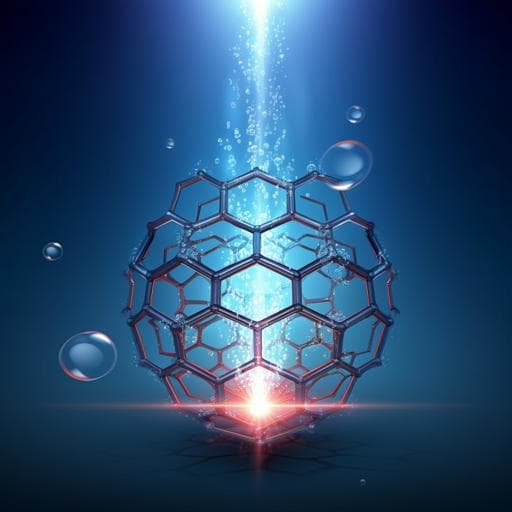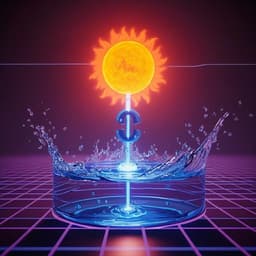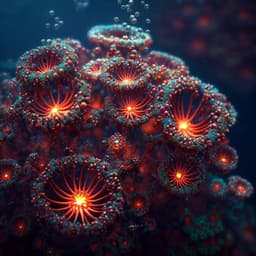
Chemistry
Direct growth of uniform carbon nitride layers with extended optical absorption towards efficient water-splitting photoanodes
J. Qin, J. Barrio, et al.
This groundbreaking research, conducted by Jiani Qin, Jesús Barrio, Guiming Peng, Jonathan Tzadikov, Liel Abisdris, Michael Volokh, and Menny Shalom, reveals a novel synthesis method for carbon nitride films that dramatically enhance optical absorption and charge separation. The developed photoanodes exhibit remarkable water-splitting capabilities, with a photocurrent density of 353 µA cm⁻², setting a new precedent in photoelectrochemical cells.
~3 min • Beginner • English
Introduction
Carbon nitride (CN) has emerged as a low-cost, stable semiconductor for photoelectrochemical (PEC) water splitting, but its performance lags state-of-the-art materials. Key bottlenecks include moderate light harvesting (visible response commonly limited to ~420 nm), poor charge separation, and a limited repertoire of methods/monomers to grow continuous CN films with intimate substrate contact. Existing deposition techniques often constrain precursor choice, require complex conditions, and suffer from scalability issues, hindering optimization of CN’s optical/electronic properties. The study aims to develop a simple, general, and scalable film-growth method enabling diverse monomers and substrates to produce CN layers with extended visible absorption, improved charge separation, strong adhesion, and enhanced PEC performance for water oxidation.
Literature Review
Prior CN film fabrication strategies include doctor-blading of supramolecular precursors, thermal vapor condensation, solvothermal growth, micro-contact printing, and various liquid-based methods. While these approaches advanced the field, they often restrict monomer choice, require special processing conditions, have scalability challenges, and can yield films with poor adhesion or limited uniformity. As a consequence, many CN photoelectrodes exhibit strong PEC response only up to ~420 nm due to wide bandgaps and suboptimal film microstructure/charge transport. Enhancing visible-light response and enabling broader, simpler synthesis routes are identified as critical needs for CN-based PEC devices.
Methodology
- Film growth concept: Rapid deposition of CN precursors directly from hot saturated solutions onto substrates, followed by high-temperature calcination under N2 to form porous CN layers intimately contacting the substrate.
- Representative synthesis (thiourea precursor, CNT): Clean FTO immersed briefly (≈1 s) in hot (70 °C) saturated thiourea aqueous solution (~0.9 g mL^-1), withdrawn and dried. Repeated dip–dry cycles control precursor thickness. Calcination under N2 at 500 °C for 2 h (5 °C min^-1 ramp) yields uniform yellow CN films (CNT; also denoted CNx/CN4 in figures).
- Surface modification via melamine vapor (CNTM): 1.0 g melamine placed at tube bottom; thiourea/FTO positioned near nozzle. Tube purged with N2, sealed, and calcined at 550 °C for 2 h to generate melamine-vapor-modified CN films (CNTM). Similar modification achievable using NH4SCN to generate vapor/pressure.
- Thickness control: Precursor layer count tunes final CN thickness from ~13 to 53 µm; e.g., optimal CNx thickness near 39 µm.
- Generality to monomers: Method applied to urea (CNU), dicyandiamide with seeding (CND), ammonium thiocyanate (CNNS), and guanidine carbonate (CNGC), forming uniform films after calcination (typically 500 °C, 2 h under N2; CND 4 h).
- Generality to substrates: Uniform CN films grown on various substrates: FTO (various sizes), carbon paper, TiO2-coated electrodes, and glass slides.
- Characterization: SEM (top/cross-section), XRD ((002) at ~27.4°, (100) at ~13°), FTIR (1200–1600 cm^-1 CN heterocycles, 810 cm^-1 heptazine), UV–Vis (direct bandgaps ~2.15–2.38 eV; extended absorption tail >700 nm), PL, XPS (C 1s, N 1s; absence of S), N2 sorption/BET (ECSA correlation), Mott–Schottky (band positions), EIS (charge transfer resistance), adhesion tests (ultrasonication; tape).
- PEC testing: Three-electrode cell; working electrode: CN film (1.2×2.5 cm substrate, 1 cm^2 active area typical); counter: Pt foil; reference: Ag/AgCl; electrolytes: 0.1 M KOH (pH 13) and 0.1 M Na2SO4 (pH 7.02); illumination: AM 1.5G, 1 sun (300 W Xe lamp with filters). Photocurrent measured at 1.23 V vs RHE (after 3 min equilibration). IPCE via bandpass filters (400–600 nm) and standard formula. Hole extraction efficiency estimated by comparing photocurrents with/without 10% v/v TEOA scavenger. Gas evolution quantified by GC; faradaic efficiencies calculated from moles of H2/O2 and charge passed.
Key Findings
- Film formation and structure:
- Direct growth from hot saturated solutions yields uniform, porous CN films with strong substrate contact; thickness tunable (13–53 µm). XRD/FTIR/XPS confirm graphitic CN structure; no residual sulfur for thiourea-derived films.
- PEC performance (thiourea-derived CNx/CN4 without melamine):
- Optimal thickness ~39 µm gives photocurrent density 266 µA cm^-2 at 1.23 V vs RHE (0.1 M KOH, 1 sun). Onset potential ~0.38 V vs RHE.
- IPCE up to 13% at 400 nm; photoresponse detectable to 600 nm.
- With 10% v/v TEOA, photocurrent increases to 470 µA cm^-2 and IPCE at 400 nm to 19%; estimated hole transfer efficiency ~57% (upper bound due to lack of plateau).
- High reproducibility across batches (±10 µA cm^-2) and consistent IPCE.
- Surface modification with melamine vapor (CNTM):
- Enhanced performance: photocurrent 353 µA cm^-2 at 1.23 V vs RHE (0.1 M KOH), IPCE 18% at 400 nm, >12% at 450 nm, ~2% at 600 nm; lower onset potential 0.32 V vs RHE.
- With TEOA, photocurrent rises to 565 µA cm^-2; hole transfer efficiency up to 62%.
- Gas evolution (0.1 M KOH): H2 1.88 µmol h^-1 cm^-2; O2 0.91 µmol h^-1 cm^-2; FE ~53% (H2) and ~51% (O2); ~50% photocurrent retained after 1 h.
- Neutral electrolyte (0.1 M Na2SO4): photocurrent 305 µA cm^-2; improved stability (≈72% retention at 1 h; minimal loss first 30 min); H2 2.26 and O2 1.08 µmol h^-1 cm^-2; FE ~55% (H2), ~52% (O2).
- Mechanistic insights: CNTM shows higher ECSA (BET 9.2 vs 6.1 m^2 g^-1), reduced hole transfer resistance (EIS), slight bandgap redshift (2.33→2.26 eV), and stronger adhesion (ultrasonication/tape tests). Post-reaction XPS indicates partial surface oxidation (C–O, N–C–O) and slight crystallinity loss.
- Generality:
- Uniform CN films prepared on diverse substrates (FTO, carbon paper, TiO2-coated, glass) with similar morphology.
- Other monomers yield high-performing films: CNU (urea) photocurrents 368 µA cm^-2 (with TEOA) and 133 µA cm^-2 (without); CND (DCDA) 277 µA cm^-2 (with) and 145 µA cm^-2 (without). Additional monomers (NH4SCN, guanidine carbonate) also produce uniform, active films.
- Adhesion and processing comparisons:
- Melamine vapor increases internal pressure during calcination, improving film–substrate contact and stability. Alternative fabrication attempts (powder calcination, slurry drop-cast, doctor-blade with thiourea) resulted in cracked, non-adherent, or infeasible films, underscoring the advantage of the proposed method.
Discussion
The study addresses key limitations of CN photoanodes by introducing a simple, scalable deposition method that broadens precursor/substrate compatibility and yields uniform, adherent films with extended visible absorption. The improved film morphology and intimate contact enhance charge separation and collection, reflected in higher photocurrents, lower onset potentials, and significant IPCE extending to 600 nm. Surface modification via melamine vapor further reduces interfacial charge-transfer resistance and increases accessible active area, boosting hole extraction efficiency (up to 62%) and overall PEC performance without co-catalysts. Gas evolution with near-stoichiometric H2:O2 ratios and substantial faradaic efficiencies confirms that the photocurrents are largely due to water splitting. The method’s generality across monomers and substrates provides a versatile platform to tune CN’s structural and photophysical properties, potentially enabling further gains in solar-driven PEC applications.
Conclusion
A rapid, general solution-to-film growth followed by calcination enables uniform, strongly adherent carbon nitride layers with extended visible-light response and enhanced charge separation. With thiourea precursors and melamine-vapor surface modification (CNTM), the photoanodes achieve benchmark performance for CN materials: 353 µA cm^-2 at 1.23 V vs RHE in 0.1 M KOH, onset 0.32 V, IPCE 18% at 400 nm (>12% at 450 nm), response to 600 nm, and faradaic efficiencies of ~53% (H2) and ~51% (O2). The approach is scalable and compatible with multiple monomers and substrates, providing a robust platform for CN-based PEC devices. Future work could focus on mitigating photoanode oxidation to improve long-term stability, integrating co-catalysts for further kinetics enhancement, optimizing electron transport (e.g., through composite architectures), and expanding film growth to more complex device geometries.
Limitations
- Stability: Under alkaline conditions (0.1 M KOH), photocurrent decreases to ~50% after 1 h due to partial oxidation and slight crystallinity loss; neutral electrolyte improves but does not eliminate decay (~72% retention at 1 h).
- Charge transport: Front-side illumination indicates suboptimal electron diffusion length; thicker films suffer increased recombination and reduced light penetration, limiting photocurrent beyond an optimal thickness (~39 µm).
- Efficiency estimation: Hole extraction efficiencies (57–62%) are upper bounds because a clear photocurrent plateau with TEOA was not achieved.
- Process specifics: Melamine vapor enhances adhesion/performance via internal pressure during calcination; performance may depend on precise vapor/pressure conditions. Doctor-blade with thiourea precursor was infeasible; slurry drop-cast films lacked durability in electrolyte.
- Surface changes: Post-reaction XPS shows formation of C–O/N–C–O species, indicating susceptibility to surface oxidation during operation.
Related Publications
Explore these studies to deepen your understanding of the subject.







